In this blog post we will take you birding through eastern Missouri, Illinois, Indiana, and Kentucky, although Kentucky is not considered the “midwest”.
24 April 2017
Said our farewells to Jack’s family in Jamesport and continued our travels east, stopping at the Clarence Cannon National Wildlife, located near Louisiana, Missouri (near the Mississippi River). This refuge looked small on the map, and in relationship to many refuges it is – at only 3,750 acres, of which over 2,000 is wetlands. We got to the refuge around 12:30 and left 3.5 hours later after driving on most of the 5.5-mile auto tour route. We did try to hike the nature trail, but it was closed due to nesting Bald Eagles. Funny, but in Homer we have Bald Eagles that nest in people yards, and it doesn’t seem to bother them. Guess it is what they are used to.
We observed a total of 39 different bird species. We got to hear the American Bittern with its unusual call, see the Sora sulking in the reeds, and watch the American Coots as they scooted across the road in front of us. We had a raccoon in the wetlands eating something and snarling at us at being interrupted. They have good size canines. Wouldn’t want to be around an angry raccoon. They are cute, however. We had a dead snake in the road but it did not look as though it had been killed by a vehicle, rather that something struck it near the head (that is where the blood was observed). There were a lot of turtles that slithered into the water as we approached in our vehicle.
And we did see a lot of those 2,000 acres of wetlands. The water seemed to be the right depth for shorebirds, although we did not see a lot – mostly yellowlegs, pectoral sandpipers, two Black-necked Stilts, and several Solitary Sandpipers – oh and one cannot forget the Killdeer. I would definitely come back and visit this refuge.
Oh and this is a new wildlife refuge for us. We are now up to 20 new refuges of the 47 visited on this trip. Woohoo!!!

The calm before the ensuing storm – Severe Thunderstorms over the Central US




Lincoln Sparrow
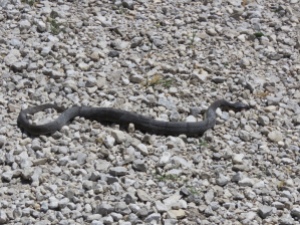
Saw this dead snake on the road. Did not know it was dead at first because it had not been flattened by a vehicle.
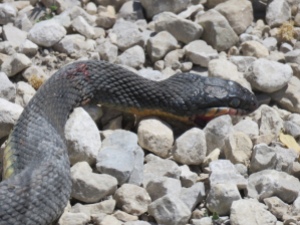
Maybe a bird stabbed it with its beak???



Song Sparrow singing its heart out

Pectoral Sandpiper in search of food
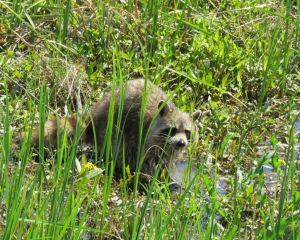
Rocky Raccoon
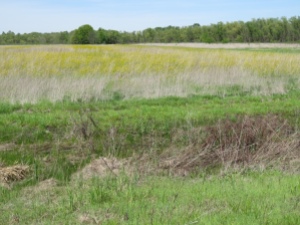


Great Shorebird Habitat

Pied-billed Grebe

A sitting duck – someone lost their decoy

Lesser Yellowleg

Trail to a platform

Dead bull frog


European Tree Sparrow
Bird Species Seen or Heard at Clarence Cannon National Wildlife Refuge:
- Canada Goose
- House Sparrow
- Bank Swallow (FOY)
- Cliff Swallow
- American Coot
- Red-winged Blackbird (there were everywhere)
- American Robin
- Great Egret
- Eastern Phoebe
- American Crow
- Great Blue Heron
- Bald Eagle
- Common Grackle
- Greater Yellowleg
- Blue-winged Teal
- Pied-billed Grebe
- Killdeer
- Blue Jay
- Lincoln Sparrow
- Song Sparrow
- Red-headed Woodpecker
- Solitary Sandpiper
- Orchard Oriole (FOY)
- Lesser Yellowleg
- Eastern Meadowlark
- Gadwall
- Sora
- Northern Shoveler
- Brown Thrasher
- Pectoral Sandpiper
- European Starling
- Savannah Sparrow
- Turkey Vulture
- Red-tailed Hawk
- Mallard
- American Bittern
- Black-necked Stilt
- Barn Swallow
- Eurasian Tree Sparrow
25 April 2017
We birded the Cuiver River State Park campground before leaving finding lots of good birds, including a First of Year (FOY) – the Warbling Vireo. Several of them flitting about in the trees, singing their hearts out.
This is a really nice park, with a nice campground. I would definitely come back for a visit in the future. Lots of hardwood forest for songbirds. We had six White-throated Sparrows searching for food at our campsite. And there were American Robins everywhere. I think they are the “campground” bird almost everywhere.
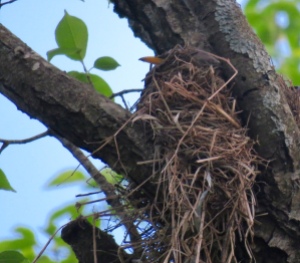
American Robin in the nest – you can see the bird’s beak

White-breasted Nuthatch
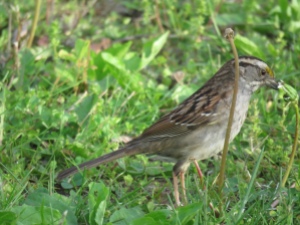
White-throated Sparrow – they loved the dandelion seeds
Bird Species Seen or Heard at Cuiver River State Park:
- Warbling Vireo (FOY)
- White-throated Sparrow
- Northern Cardinal
- American Robin
- Turkey Vulture
- Blue Jay
- White-breasted Nuthatch
- Chipping Sparrow
- Blue-gray Gnatcatcher
- Eastern Phoebe
- Wild Turkey
- Yellow-rumped Warbler
From the campground we headed north to Louisiana (the town) and then across the Mississippi River into Illinois. We took back roads to get to Two Rivers National Wildlife Refuge. The refuge does not offer an auto tour route, but they do have a number of trails/dikes you can walk, which we did. One of the trails is located near the Visitor Center. This trail actually produced at least half the birds for us, and it was less than a mile long.
The 9,225 acre Two River National Wildlife Refuge was established in 1958 and consists primarily of riverine and floodplain habitat. The refuge borders both the Mississippi and the Illinois Rivers. The refuge is composed of several different “divisions”. We visited both the Calhoun and Gilbert Lake Divisions. To get from the Calhoun division to the Gilbert Lake division we took the Brussels Ferry across the Illinois River.
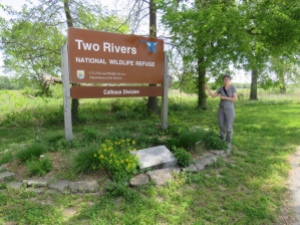
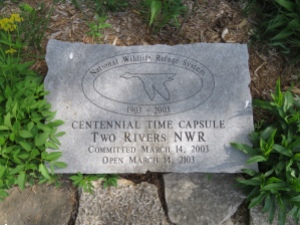
Some of the refuges have these time capsules. Would love to see what is inside, but I won’t be around in 2103 to find out.

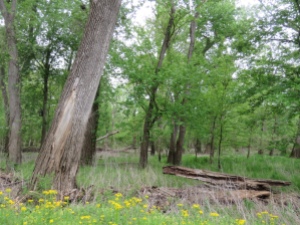

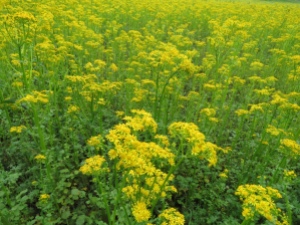

Greater Yellowleg
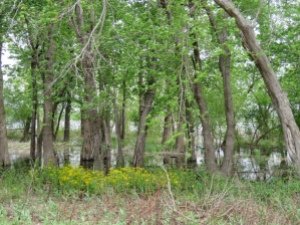

Roads open to foot traffic

Muskrat den



Navigational buoy on the trail next to the Illinois River, which seemed high to us. Am sure it flooded shortly after we left.

Three-mile trail on the Gilbert Lake Tract
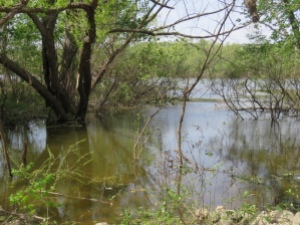
Bird Species Seen or Heard at Two Rivers National Wildlife Refuge:
- Common Grackle
- Red-winged Blackbird
- White-throated Sparrow
- White-crowned Sparrow
- Bald Eagle
- Eastern Kingbird
- Northern Mockingbird
- Brown Thrasher
- Mallard
- Great Blue Heron
- American Robin
- Northern Cardinal
- Turkey Vulture
- Northern Bobwhite
- Northern Parula
- Swamp Sparrow
- Wood Duck
- American Coot
- Blue-winged Teal
- Greater Yellowleg
- Lesser Yellowleg
- Canada Goose
- Northern Flicker
- Song Sparrow
- Brown-headed Cowbird
- American Goldfinch
- Palm Warbler
- Great Egret
- Northern Waterthrush (FOY)
- Solitary Sandpiper
- Red-tailed Hawk
- House Wren
- Tree Sparrow
The night was spent at the Pere Marquette Illinois State Park, which borders the Gilbert Lake Division of the Two River NWR. This is a good size park, and guess what – more American Robins.
26 April 2017
Woke around 4:00 am to the sound of rain hitting our tin tent, as I like to say, – the top of the van. When the rain hits the roof it can be quite loud.
The rain quit before we had to break camp and head south to our next new refuge – Crab Orchard National Wildlife Refuge. This refuge is located about 150 miles south of Two Rivers NWR – in southern Illinois.
Crab Orchard National Wildlife Refuge was established in 1947 and contains 43,890 acres. Industrial activities occur on part of refuge – primarily manufacturing and storage facilities. Many buildings now housing industries were used in the manufacturing of explosives during World War II, and they are still used for military ordnance production today.
We got to the refuge around 1:00 pm and stopped off at the Visitor Center for the requisite brochure and bird checklist. The refuge offers a wildlife tour route, which we drove a portion of, but before doing that we did a short hike to a fishing pond near the refuge. This place was a bonanza – great birding. The checklist has the Yellow-rumped Warbler as an “uncommon” species during the spring. Well they were everywhere. The majority of the birds we spotted along this hike were Yellow-rumped Warblers. There were three surprise birds – a Protonotary Warbler, Bell’s Vireo, and an Indigo Bunting (male). Of these the Protonotary Warbler was prize – and I almost got a photo of this beautiful bird. Such bright yellow head and breast. Beautiful!!!
As mentioned, we did drive a portion of the wildlife route, spotting a dozen or so Wild Turkeys. Tis the season for mating. The male turkeys were strutting and flashing their tails. The females didn’t seem to care one iota. As we were driving, the rains started and I mean RAIN. We had received a warning of a Severe Thunderstorm alert. Once it started raining we thought we should go to our campsite for the night. The refuge has several campgrounds. We are staying the night at the Crab Orchard Lake campground. For $10 (a night) we can get a site with electricity and water because of the Golden Age Pass.
We got to the campground around 4:30 pm. It had stopped raining and we decided to just get a basic site – no electricity. This campground only offers four (4) such sites. Once parked we set up camp when the skies opened up. Talk about rain (and thunder and lighting, oh my). I think we had about a 0.5 inch of rain in less than 30 minutes. The rain would come and go, which allowed the birds to come out again and again. It’s kind of nice to just sit in the car and watch all the birds flying back and forth, landing on the ground feeding. We had a Pileated Woodpecker land about 30 feet from the vehicle on a old stump. A Baltimore Oriole was singing in the tree above the van. A Wood Duck was in the cove swimming in the rain. The Northern Cardinals were chasing each other. And there must have been at least 20 Canada Geese – some with goslings already – feeding in the campground loop. The parents extend their necks forward encouraging the youngsters to move along. I think we saw more birds in the campground than all of the rest of the refuge.
With all the rain, the basic camping sites were filling up with water, so I suggested to Jack that we move to an electric site, since those sites are on gravel pads – not grass. Two hours later and it is still raining (and not expected to stop until sometime tomorrow around 7:00 am). It will be interesting to see how much water accumulates.
Tomorrow we plan to visit more of the refuge before heading northern to spend a few days with Jack’s son and his family.
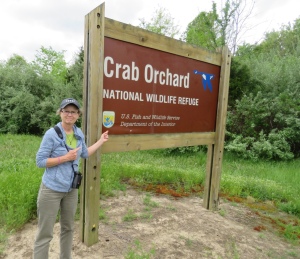
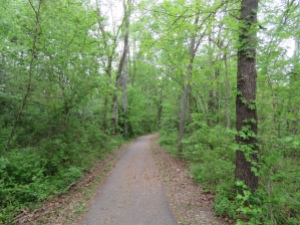
Trail to the pond near the visitor center





Wild Turkey
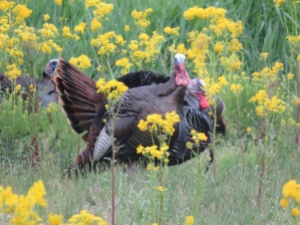

Eastern Phoebe


Baltimore Oriole
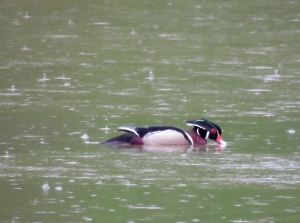
Wood Duck in the rain
Bird Species Seen or Heard at Crab Orchard National Wildlife Refuge:
- Chipping Sparrow
- Eastern Phoebe
- Indigo Bunting
- Double-crested Cormorant
- Yellow-rumped Warbler
- Palm Warbler
- Protonotary Warbler (FOY)
- Northern Cardinal
- Bell’s Vireo (FOY)
- Carolina Chickadee
- Northern Parula
- Blue-gray Gnatcatcher
- White-throated Sparrow
- Brown-headed Cowbird
- Eastern Bluebird
- Blue Jay
- American Crow
- Red-winged Blackbird
- Wild Turkey
- Canada Goose
- Barn Swallow
- European Starling
- Common Grackle
- Eastern Towhee
- American Robin
- Mallard
- Wood Duck
- Red-bellied Woodpecker
- Forester’s Tern
- Ring-billed Gull
- Pileated Woodpecker
- Common Yellowthroat
- Eastern Kingbird
- Tree Swallow
- Northern Flicker
- Baltimore Oriole (FOY)
- Brown Thrasher
- Warbling Vireo
- Mourning Dove
27 April 2017
Well at least it wasn’t raining when we woke up. I was surprised how much of the fallen rain had already soaked into the ground. Not as much standing water as I expected. The plan was to pack up and go bird the refuge, but we decided to just bird the campground (which is technically in the refuge). I’m sure glad we did.
In the campground we just sat in our vehicle to see what birds might fly in. I noticed a bird on the ground and checked it out. It was a juvenile Blue Grosbeak. Jack was happy to see the bird because this is one bird on his list of “birds I want to see this trip”. Of course he would rather see the male in all its blue, blazing glory. But we still have that opportunity.
We walked to Loop B, which is closed for renovations. This proved to be fruitful area to bird. When we were in Missouri I told Jack if we wanted to see the Summer Tanager we would need to see it there as the further north we got, the less likely we would be to see the bird. Well Crab Orchard NWR is in southern Illinois so we were still within its range and I spotted a male in the tree. At first I saw a red bird and thought Northern Cardinal. But something seemed off. The color and shape were wrong. So up go the binoculars and sure enough there was the Summer Tanager. Woohoo!!! A trip bird (aka First of Year – FOY).
Where the road empties into the campsite, the refuge staff has conducted some small prescribed burns. In one location we spotted a Baltimore Oriole and an Orchard Oriole. Two beautiful, colorful birds. North America lacks the multitude of colorful birds found in other countries, but it does have a few like the Orioles, Tanagers, and Warblers.
In the campground alone we had 39 different species – and good ones at that (Northern Parula, Yellow-throated Warbler, Baltimore and Orchard Orioles, Brown Thrasher, Summer Tanager – just to name a few). Of these, three were FOYs: Blue Grosbeak, Summer Tanager, and Yellow-throated Warbler.
From the campground we went back to the Wildlife Drive, stopping first at the Pigeon Creek Day Use Area. Again, we parked and just sat in our car watching to see what birds would come into a recent burned area. We had Palm Warblers, Yellow-rumped Warblers, Eastern Bluebirds, Blue Jays, Chipping Sparrows, and a Swainson’s Thrush (FOY). The Yellow-rumped Warblers kept chasing off the Palm Warblers, but they weren’t too deterred.
At the day use area there is a 1.0 mile hike (Harmony Trail), which we took. The trail led us through hardwood forests and to a bird blind overlooking a wetland area. At the wetland there was a Belted Kingfisher that had just caught something and was proceeding to bash it against the wires it was on and then eating it. Fun to watch nature.
Through this area we had Carolina Chickadees calling, the Tufted Titmouse with its loud “Peter, Peter, Peter” call, a Yellow-throated Vireo with a bug in its beak, and a singing Blue Grobeak. The forest was alive with birds singing and calling out. So beautiful to listen to. I just wish I knew all the bird songs and calls. One sounded like a hoarse Thank you. Don’t have a clue as to what bird is singing that song.
After the hiked we continued along the Wildlife Drive finishing the drive at a meadow where we hear the distinctive call of the Dickcissel (another FOY) – dick cissel cissel. The bird likes to sing from the barb wired fence. I’m good with that. Easy to find them. We also heard several Northern Bobwhites close by, but well hidden in the foliage on the nearby forest edge. They stick to the forest edges. There were lots of Tree Swallows and several Eastern Kingbirds sharing the overhead wires. When we turned around to go back the way we came, suddenly on the fence was another bird we hoped to see – the Bobolink. What a treat! This is a very distinctive bird. These birds are rare for the refuge, so we felt very fortunate to see not one, but two on the barbed wire fence. They stuck around long enough for several photographs, and then flew off to points north, most likely.

Forester’s Tern



This Ring-billed Gull had a hard time balancing on the buoy – fun to watch

Chipping Sparrow

Blue Grosbeak near our camp site

Several Canada Goose families in the campground

Cute little Goslings. Their wings are so small and undeveloped


Summer Tanager

Two Male Brown-headed Cowbirds. Cowbirds parasitize other nests. So some of us have come up with the song “Momma Don’t Let Your Baby Grow Up to be Cowbirds …”

Baltimore Oriole
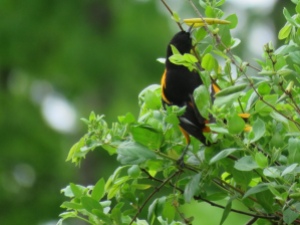
In the tree searching for bugs

This Red-headed Woodpecker was all puffed up trying to keep warm

Blue Jay
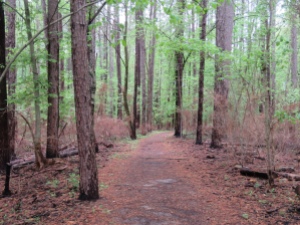
Harmony Trail
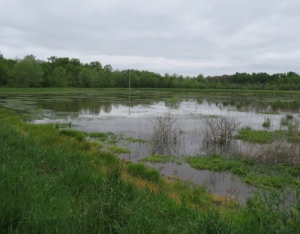
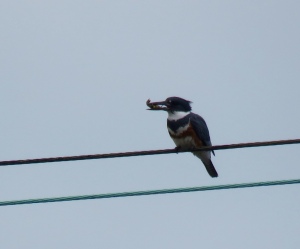
Terrible lighting for photographing birds, and sometimes even seeing them. Here a Belted Kingfisher with food in its mouth.

Indigo Bunting

Blue Grosbeak


Canada Goose on a nest

Lots of (oak) leaves on the trees

Great Blue Heron …

… up close

Dickcissel


Common Yellowthroat

We haven’t seen a whole lot of these birds lately so was nice to see this male singing away

Eastern Kingbird


These nest boxes all had bird names – here the Bell’s Vireo

Tree Swallow
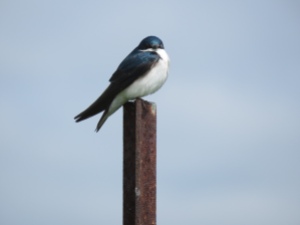
Doesn’t look happy to be interrupted (or photographed)


Northern Rough-winged Swallow
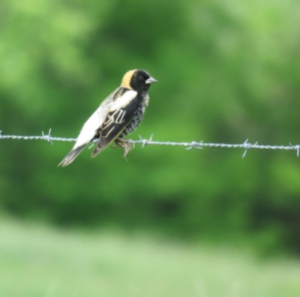
Woohoo!!! A Bobolink. Wasn’t sure we would get to see this bird on our trip.
Bird Species Seen or Heard at Crab Orchard National Wildlife Refuge (today)
- American Robin
- Northern Cardinal
- European Starling
- Canada Goose
- American White Pelican
- Ring-billed Gull
- Warbling Vireo
- Song Sparrow
- Red-winged Blackbird
- Double-crested Cormorant
- Eastern Kingbird
- Common Grackle
- Northern Mockingbird
- Mourning Dove
- Chipping Sparrow
- Carolina Chickadee
- Blue Grobeak (FOY)
- Tree Sparrow
- Yellow-rumped Warbler
- Northern Parula
- Turkey Vulture
- Summer Tanager (FOY)
- Baltimore Oriole
- Orchard Oriole
- Brown Thrasher
- Red-headed Woodpecker
- Great Blue Heron
- Lesser Scaup
- Common Goldeneye
- Killdeer
- Northern Flicker
- Blue Jay
- Field Sparrow
- Pileated Woodpecker
- Chimney Swift
- Cliff Swallow
- Barn Swallow
- Northern Rough-winged Sparrow
- Yellow-throated Warbler
- Indigo Bunting
- Eastern Bluebird
- Palm Warbler
- Swainson’s Thrush (FOY)
- Eastern Phoebe
- Belted Kingfisher
- Red-shouldered Hawk
- Red-tailed Hawk
- Great Egret
- Common Yellowthroat
- Blue-gray Gnatcatcher
- Yellow-throated Vireo
- Tufted Titmouse
- Fish Crow
- Wild Turkey
- Caspian Tern
- Bald Eagle
- Dickcissel (FOY)
- Hooded Merganser
- Northern Bobwhite
- Bobolink (FOY)
- Mallard
This is a great refuge and one I would definitely come back to visit. I’m glad we decided to take a detour to visit.
Our next destination is the home of Jack’s son and his family near Oakland, Illinois. We plan to stay here two full days, and with lots of rain and thunderstorms in the forecast – probably a good idea.
28 April 2017
Today is down day – laundry, blogging, and just relaxing. Raining like crazy outside – severe thunderstorm alert.
29 April 2017
Another down day – still more rain, thunder, and lightening. Some flooding of farm fields.
30 April 2017
We left central Illinois around noon and headed to our campground for the night – Starve Hollow State Recreation Area in Indiana. This is the first time either of us has been to Indiana. I like this state (at least the part I’ve seen) much better than central Illinois. Central Illinois is flat, while southern Indiana is rolling hills. Much prettier.
The campground only had three other campers when we arrived. People are probably avoiding the weather – staying home and staying dry. There are a lot of great birds in the campground, and saw our first Ruby-throated Hummingbird for the year.
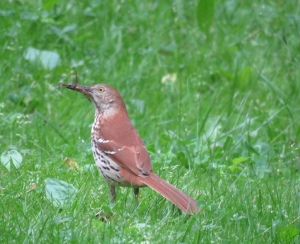
Brown Thrasher with dinner in its beak
Bird Species Seen or Heard at Starve Hollow State Recreation Area
- American Robin
- Brown Thrasher
- American Goldfinch
- Northern Cardinal
- Baltimore Oriole
- Great Blue Heron
- Blue Jay
- Carolina Chickadee
- Chipping Sparrow
- Common Grackle
- Northern Parula
- Mourning Dove
- Blue-gray Gnatcatcher
- Ruby-throated Hummingbird (FOY)
- Yellow-rumped Warbler
- Eastern Towhee
- Canada Goose
- Red-bellied Woodpecker
- Hairy Woodpecker
- American Crow
- Turkey Vulture
- Barn Swallow
1 May 2017
Happy May Day everyone. We visited the 7,724-acre Indiana Muscatatuck National Wildlife Refuge. This refuge was established in 1966 to provide habitat for migratory birds and endangered species. We drove the 4-mile Wildlife Drive and walked the one-mile Wild Turkey Trail. We only observed 35 species of birds, but what we did see made us happy. We saw a beautiful male American Redstart and a Yellow-breasted Chat. We also had two Green Herons skulking in the vegetation near waterbodies.
This is a new refuge for us, but one I would gladly visit again and again. We spent about 4 hours on the refuge today. We probably would have stayed longer but I wanted to visit the Big Oak National Wildlife Refuge located about 30+ miles away. This refuge is only open to the public on Mondays, Fridays, and the second and fourth Saturday of each month. Since today is Monday, if we wanted to visit the refuge we needed to go today.

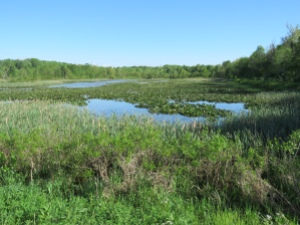

Green Heron

Indigo Bunting
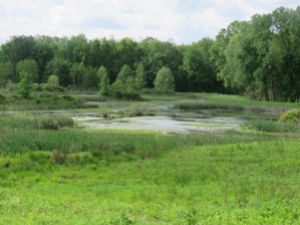

Canada Goose – most of the waterfowl are gone now



The Wild Turkey Trail – wet, wet, wet

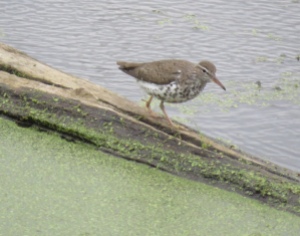
Spotted Sandpiper
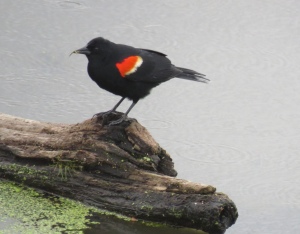
Red-winged Blackbird

This American Robin’s nest was on an electrical box attached to the visitor center



Refuge Map
Bird Species Seen or Heard at Muscatatuck National Wildlife Refuge:
- American Robin
- Canada Goose
- Northern Cardinal
- American Redstart (FOY)
- Northern Parula
- Blue-gray Gnatcatcher
- Spotted Sandpiper
- Red-winged Blackbird
- Common Yellowthroat (nice to see so many here)
- Great Blue Heron
- Yellow-rumped Warbler
- Yellow-breasted Chat (FOY)
- Indigo Bunting
- Chipping Sparrow
- White-crowned Sparrow
- Carolina Chickadee
- Turkey Vulture
- Yellow Warbler (FOY)
- Brown Thrasher
- American Crow
- Tree Swallow
- Wood Duck
- Mourning Dove
- Great Egret
- Pied-billed Grebe
- Blue-winged Teal
- Eastern Phoebe
- Copper’s Hawk
- Carolina Wren
- Swainson’s Thrush
- Blue Jay
- Ruby-crowned Kinglet
- American Coot
- Hairy Woodpecker
The 50,000 acre Big Oaks National Wildlife Refuge is an overlay of the Jefferson Proving Grounds. The U.S. Army vacated the site in 1996 and the refuge was established in 2000. Since there is still a lot of unexploded ordinances around, the refuge staff requires visitors to watch a safety video. We arrived at the refuge around 2:15p.m., only to find no staff available to show us the video, plus the refuge would be closing in a couple of hours since they were on a short day due to an early morning turkey hunt. The refuge manager, Joseph Robb, graciously offered to see if any volunteers would be available tomorrow to take us around the refuge. One did offer their services so it is a go. This refuge has both Cerulean Warblers and Henslow Sparrows – both highly sought after and difficult to find birds.
We are camping the night at Clifty Falls State Recreation Area, located near the refuge. We are the only campers in the non-electric loop. That is okay with us. Too windy to do much birding so am writing my blog. Hopefully tomorrow won’t be as windy.
2 May 2017
Made it to the refuge by 8:00 am to meet our guide George. He has been volunteering with the refuge for over ten years and offers tours of the refuge on behalf of the refuge staff (which we learned consists of one non-maintenance permanent employee- the manager – who is also responsible for Muscatatuck refuge). There is only a small section (NE section of the refuge) open to the public, and again this is limited to two days a week and two Saturdays a month. One nice aspect of having a guide is that you get to go to where the birds are, which isn’t necessarily in the public use area.
We did watch a safety video and signed a paper promising, at risk to life and limb, not to pick up anything metal and to watch were we stepped, if outside of our vehicle. The refuge does have contractors out removing some of the ordinances, which we did see in a pile alongside the road. That is one job I would not want.
The Indiana Air National Guard operates an air-to-ground bombing range on the remaining 1,033 acres of the former proving ground north of the firing line. This property is surrounded by but not designated as part of the refuge. As we were starting out we learned the Air Guard would be conducting maneuvers on the refuge and we would need to be off by 1:00 pm. There are a number of locked gates on the refuge and air force personnel would be coming around the refuge beginning at 11:30 am to be sure these gates were locked. So that would limit the time we had available for our tour.
George took us to a meadow area where we saw a lot of great birds, including the Henslow’s Sparrow. Woohoo!!! This bird throws its head back when it sings. We’ve seen this bird before in Wisconsin, but we had a difficult time finding it there. George said there are around 200 or so breeding pairs on the refuge. We also saw a number of Yellow-breasted Chat. In the west, these birds are uncommon so nice to see so many of them on the refuge.
We then proceeded to an area where the Cerulean Warbler has been seen in the past. We checked four different locations, but with the wind (10+ mph) and the air force jets thundering overhead (boy those things are LOUD), we couldn’t hear or see any Cerulean Warblers. We did see at these locations and others – Scarlet and Summer Tanagers, Baltimore and Orchard Orioles, Blue and Rose-breasted Grosbeaks, Prairie Warbler (what a beautiful warbler) to name a few. In all we had 46 different species after four hours of birding. I would definitely come back to this refuge again – with a volunteer….Thanks George!


Lot of roads (mostly gravel) on the refuge

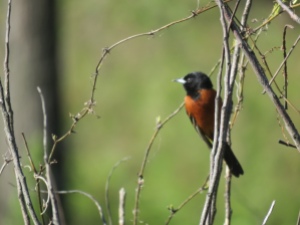
Orchard Oriole

Yellow-breasted Chat

Bird Species Seen or Heard at Big Oaks National Wildlife Refuge:
- Brown Thrasher
- Northern Mockingbird
- Eastern Bluebird
- Turkey Vulture
- Baltimore Oriole
- Prairie Warbler (FOY)
- Field Sparrow
- Yellow-breasted Chat
- Orchard Oriole
- Eastern Kingbird
- Blue Grosbeak
- Common Yellowthroat
- Red-winged Blackbird
- Swamp Sparrow
- Chipping Sparrow
- Song Sparrow
- Henslow’s Sparrow (FOY)
- Northern Flicker
- Blue Jay
- Brown-headed Cowbird
- European Starling
- Swainson’s Thrush
- Scarlet Tanager
- Northern Parula
- Northern Cardinal
- Palm Warbler
- Summer Tanager
- Tufted Titmouse
- American Redstart
- Red-headed Woodpecker
- Carolina Chickadee
- Mallard
- Eastern Meadowlark
- Indigo Bunting
- Black Vulture
- Canada Goose
- Wild Turkey
- Yellow-rumped Warbler
- Rose-breasted Grosbeak (FOY)
- American Robin
- American Goldfinch
- Pileated Woodpecker
- Red-tailed Hawk
- American Crow
- Blue-gray Gnatcatcher
- Common Grackle
Big Oaks NWR is another new refuge for us. After we said our goodbyes, we went in search of lunch. After filling our bellies with food we had to decide where we wanted to spend the night. Since neither of us has been to Kentucky, and Kentucky was only about 10 miles away, we decided to head south and east in search of a campground. We chose Kincaid Lake State Park near Falmouth, Kentucky. Like most of our trip, we chose the back roads to get to the campground. Most of the time was spent on narrow roads traversing the tops of rolling hills, and rarely were there no houses within sight. We also saw a lot of barns painted black. I googled to find out why. Seems that barns painted black retained heat better for drying tobacco. Even though today many of the barns are not used to store tobacco, the tradition of painting a barn black continues.
We got to the campground around 4:00 pm, found our campsite (we are the only ones in our campground loop), and proceeded to bird the immediate area. Lots of good birds here too – some of the same ones we observed at the refuge – Scarlet Tanager, Orchard and Baltimore Oriole, Tufted Titmouse. We also saw an Osprey. Haven’t seen one of those in awhile. We several Red-eyed Vireo (FOY), including one in the tree right next to our campsite (parking lot and campsite birding remains the best). The friendly vireo posed for me, however, whenever I went to take a photo the wind would blow leaves in front of the bird. It was another windy day. Where is all this wind coming from. The woman who registered us excitedly told us there was a Bald Eagle at the lake – didn’t have the heart to say those are a dime a dozen in Alaska….

Chipping Sparrow – we’ve seen a lot of these lovely birds

Baltimore Oriole
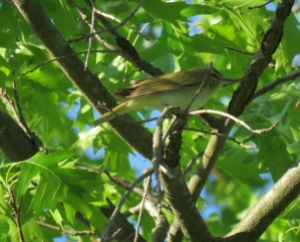
Red-eyed Vireo in the tree near our campsite
Bird Species Seen or Heard at Kincaid Lake State Park, Kentucky:
- Northern Cardinal
- American Crow
- Canada Goose
- Common Grackle
- American Robin
- Blue Jay
- Yellow-rumped Warbler
- Chipping Sparrow
- Carolina Chickadee
- Tufted Titmouse
- Baltimore Oriole
- Orchard Oriole
- Northern Flicker
- Red-eyed Vireo (FOY)
- Blue-gray Gnatcatcher
- Eastern Kingbird
- Turkey Vulture
- Scarlet Tanager
3 May 2017
This morning we decided to bird the campground before leaving Kentucky and heading into Ohio. We spent about 3 hours walking the campground and searching for birds. We didn’t find any new FOYs (First of Year birds), but we did see some new birds for Kentucky, including the Bald Eagle.
An Eastern Phoebe is nesting in an overhang at the restrooms, flitting to and fro. The Orchard Orioles are always chasing the Baltimore Orioles away, and the Common Grackles chase everything away.

Eastern Phoebe
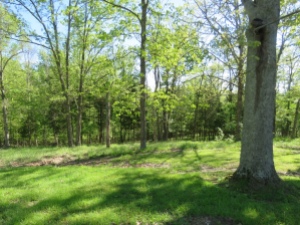
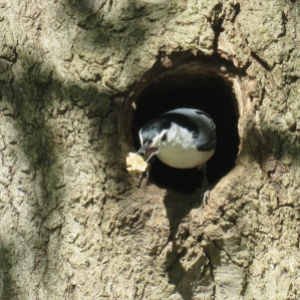
White-breasted Nuthatch

The trees here are tall. Hard to find a small little warbler at the top.

This is a tent campsite. I wonder where the level ground is for one’s tent?
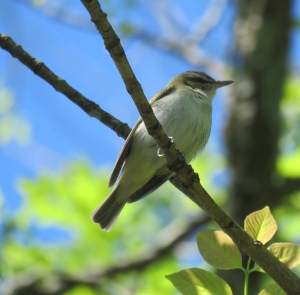
Red-eyed Vireo. Lots of vireos in this park.

In flight

American Goldfinch
Bird Species Seen or Heard at Kincaid Lake State Park, Kentucky (Day 2):
- Bald Eagle
- Red-bellied Woodpecker
- Baltimore Oriole
- Orchard Oriole
- Chipping Sparrow
- Eastern Kingbird
- American Robin
- Northern Cardinal
- Turkey Vulture
- Great Blue Heron
- Blue Jay
- Northern Flicker
- Blue-gray Gnatcatcher
- Red-eyed Vireo
- Mourning Dove
- Eastern Phoebe
- American Goldfinch
- Common Grackle
- Carolina Chickadee
- Rudy-throated Hummingbird
- Brown Thrasher
- Yellow-rumped Warbler
- Scarlet Tanager
- Tufted Titmouse
- Canada Goose
- Brown-headed Cowbird
- Pileated Woodpecker
There were only four other campers in the campground, including two campers from Alaska. Small world. The park ranger told Jack that people come to the campground in large part because someone is building a replica of Noah’s Ark nearby. They come to see his work. She asked us if we had come to see it too. Not unless it is a bird attractant.
Once we left the park, we were again driving the hilltops, with houses on each side of the ridge line, on a narrow road. There is some farmland, although much of it looks to be pasture or farmed for hay. Of course not being familiar with the roads, and fearing on-coming traffic, we drive slow which I think infuriates local drivers. And again, we saw black barns.
Off to Ohio, which I will post in a future blog. Stay tuned. Until then …
IT’S A GREAT DAY TO BIRD




















































































































































































































































































































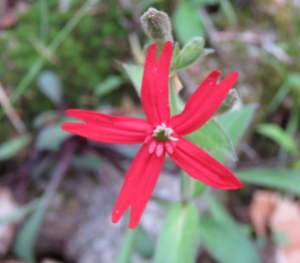

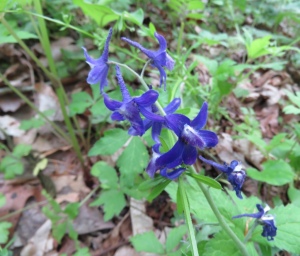


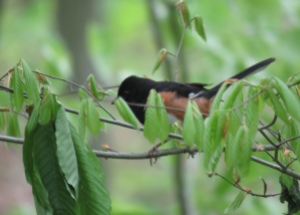


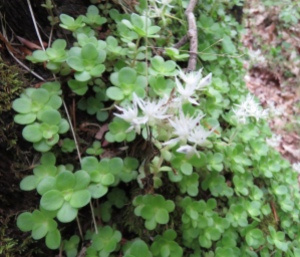

































































































































Recent Comments